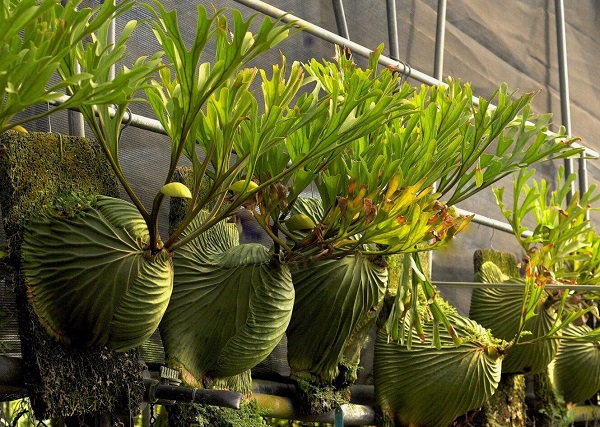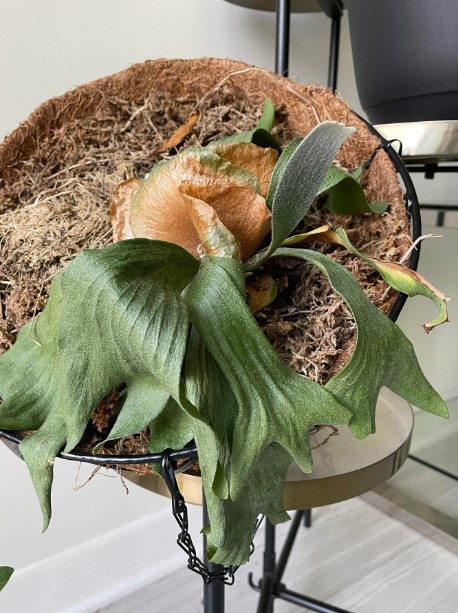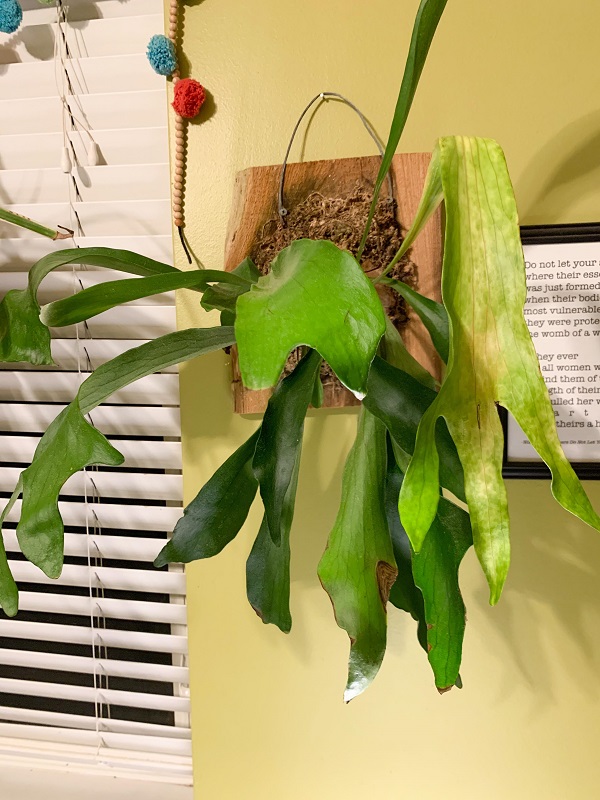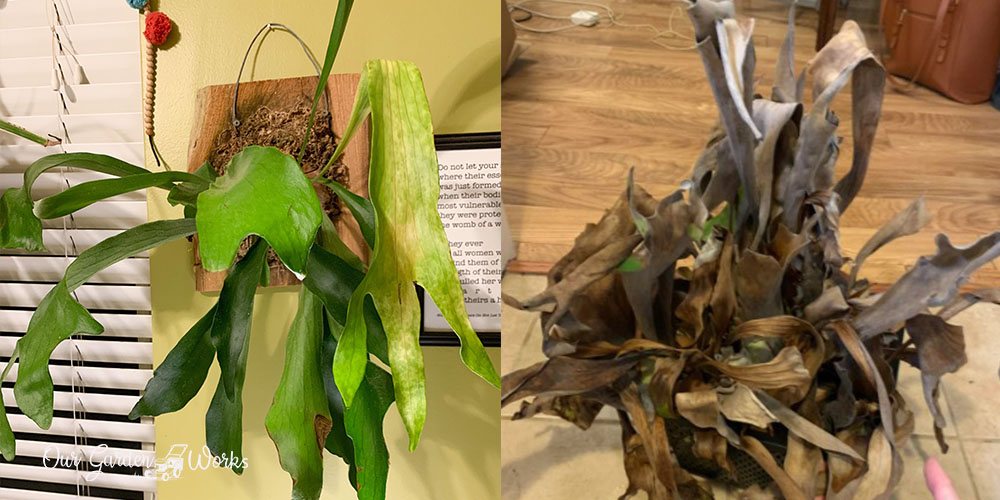Staghorn fern is easily one of the most decorative tropical houseplants gardeners rave about.
Their beautiful leaves resemble the antlers of a deer and has pot-like sterile leaves that cover their roots. Though they’re easy to grow, they can still end up with some issues over time.
In this post, learn how to save a dying staghorn fern and keep it as a part of your tropical plant collection. We will also share the telltale signs that these epiphyte plants are dying.
Staghorn ferns has a unique way of propagating, which is often mistaken as a plant problem. Learn more about these unique plant features and be mesmerized by this rare houseplant.
Staghorn fern in-depth
Staghorn fern is an epiphytic plant that grows on trees or hanging pots through its aerial roots.

In the wild, it thrives under the canopies of trees like Monstera and Philodendron. They grow in warm and humid climates and thrive in bright dappled sunlight.
Staghorn fern is popular for its two sets of leaves: sterile leaves and antler leaves. Unlike other plants, ferns propagate by spreading their spores. These spores are spread by the antler leaves during maturity.
When the antler leaves start to produce spores, they turn into a brownish tan color. Its changes in color is usually mistaken as the browning of leaves due to plant issues, but it is just a natural process for ferns.
On the other hand, the sterile leaves are called sterile because they do not produce or contain spores. They simply cover the lower part of the plant and keep the roots out of plain sight.
What are the signs that it is dying?
Not all signs of plant health decline mean your staghorn fern is dying. Sometimes, they are just experiencing stress that can still be manageable like droopy leaves.
However, it will need immediate attention if you notice any of the following conditions:
Antler leaves are turning brown starting from the base

The antler leaves with spreading brown patches from the base can indicate rotting which can spread throughout the plant. It is a condition usually caused by overwatering.
Once the stems and the base are overruled by rotting parts and left untreated, the plant may fail to recover and die.
In some cases, it may also indicate a fungal disease that spreads through spores and lands on areas with high moisture levels like overwatered staghorn ferns.
Black or brown tips on antler leaves
Black or brown tips can indicate sun damage or extreme drought stress. Staghorn ferns may still have green leaves but are already struggling with drought stress. They particularly love water as long as there’s good ventilation.
Otherwise, pathogens will start to take advantage of the stagnant moisture and infect the plant.
Another possible cause is exposure to direct sunlight. The delicate leaves of staghorn fern cannot withstand the harmful rays of the sun.
So, when the afternoon sun hits the leaves they suffer from sun damage such as brown or black tips.
Antler leaves dropping
If green antler leaves are dropping, then maybe you’re watering or misting them too much. Staghorn ferns are neglect-friendly plants and too much love through watering can slowly kill them.
The dropping leaves is the staghorn fern’s way of saying it needs some space to dry out before you water them again. It’s also possible that the planting medium you used is retaining too much water that causes overwatering issues.
Crispy dry leaves

Staghorn ferns can be resilient to sun damage and extreme heat but not with freezing temperatures. If they are left outdoors, they may suffer from frost damage and become crispy dry.
Though they may look like dead, they still have a slim chance to grow back during summer but there’s no guarantee on when and how long they will take to develop new growth.
How to save a dying staghorn fern
Staghorn ferns are well known for their resilience. You may see them at the brink of death but they won’t just succumb to extreme plant stress that easily. With your help, they can recover fast and show you their marvelous comeback.
Learn how to save a dying staghorn fern based on its specific issue below.
Drought-stress: Prune and soak
Severe drought stress in staghorn ferns can cause them to drop leaves and have brown patches.
The best way to treat them is to rehydrate them in water and remove their dead parts. Here’s how:
(1) First, remove the staghorn fern from its board or pot. You can keep it on the board if it’s small. As long as it can fit in a pail or basin, you no longer need to remove them from their frame.
(2) Submerge the plant facing down and make sure all of its parts are submerged in water.
(3) Let it sit in water overnight to allow the roots and other plant parts to rehydrate.
(4) On the next day, remove the staghorn fern in the water and inspect the leaves.
(5) You’ll notice that the healthy leaves will spring back to life. However, damaged and dead leaves will have a mushy texture with rotten parts.
(6) Prune the dead leaves from their base and mount the plant back to its board or plant it back on its pot.
(7) Let it dry out on a shaded patio and keep it away from the direct afternoon sun.
(8) Once you notice a great improvement on its leaves and found new growth, you may place it back indoors.
Decrease or increase sunlight exposure: Sun damage and slow growth
The harsh direct sun can scorch the delicate antler leaves of staghorn ferns. It also causes heat stress that can weaken the plant and make it more susceptible to pests and diseases.
If you accidentally left your staghorn ferns outdoors and under the heat of the sun, place them in the shade as soon as possible.
Sadly, you can no longer do anything about the scorched leaves. They will no longer turn green and will wither away over time.
The only thing you can do is to remove your staghorn ferns from the state of drought and heat stress through the following steps.
(1) Deeply water them or soak them in water for an hour or two. If they’re not too dry, you may simply mist them well to rehydrate their leaves and roots.
(2) Once done, let them sit in the shade where they can receive indirect light. The best location for their recovery are as follows:
- Next to an east-facing window.
- On a shaded patio.
- Under a tree.
- Next to a glass door.
(3) Prune or cut off the damaged leaves to help the plant preserve its energy in developing new growth and recovering from stress
(4) Once new growth has emerged, you may place them back indoors.
Prevent disease by improving ventilation
Epiphytes rarely get fungal diseases but when pathogens start to infect their leaves, the disease can spread fast and infect all your staghorn ferns in a span of days.
If you notice black spots on the sterile leaves or basal fronds that spread toward the stem or roots, then you’re more likely dealing with Rhizoctonia.
Rhizoctonia is a fungal disease that usually develops in a very humid environment and in waterlogged plants. It’s a secondhand plant problem that usually occurs when a staghorn fern is overwatered.
Most gardeners use a copper fungicide to stop the rapid spread of this disease on other plants such as Bonide Copper 4E Fungicide.
Though copper fungicides can prevent the spread of the disease, you may need a stronger formula to thoroughly kill the pathogens on the infected plant.
The University of Florida suggests the use of Terraclor or Terraguard to fully manage Rhizoctonia on ornamentals and other houseplants.
Once done with the treatment, you can adjust your setup and avoid disease-causing practices to prevent the re-occurrence of the disease on your other staghorn ferns.
Here are some precautionary steps that you must do while treating the infected ones:
(1) Cut off the infected parts and keep them in a plastic bag to prevent the spread of the spores of the disease.
(2) Sanitize all of your tools and separate the infected plant from the rest of your staghorn fern collection.
(3) Adjust the humidity level around your staghorn fern and improve the ventilation to prevent the development of diseases.
(4) You should also water them less than recommended. Since these epiphytes are mounted, it can be hard to identify their moisture level using a moisture meter. So, some gardeners wait for the plant to show some signs of wilt before they water them.
Staghorn ferns are more prone to overwatering and would encounter more issues when it is overwatered than being left to dry.
For infected plants, you may cut off the watering for a couple of weeks to ensure that the excess moisture has a chance of drying up.
(5) Once your fern has recovered, mix a few drops of fish emulsion fertilizer when watering your staghorn ferns to help them recover in full health and improve their resistance against diseases.
Improve indoor humidity
Aside from watering them sparingly, tropical epiphytes like staghorn ferns thrive and develop their best leaves when they get 70% to 80% humidity levels.
Low humidity often leads to droopy staghorn leaves that can eventually kill the plant if not adjusted.
When the temperature rises or when it’s warm, the level of humidity increases. However, when it’s cold or extremely hot the humidity level decreases. The ideal temperature for staghorn ferns is at least 55°F.
Once the indoor or outdoor temperature goes beyond that range, the staghorn may not get enough moisture from the air to maintain its healthy leaves and sustain its overall health.
To maintain a healthy indoor humidity for your tropical staghorn ferns, here are some natural ways that you can try:
(1) Misting can help improve the local humidity around your ferns. However, do not overdo it as it may contribute to overwatering issues that cause the dropping of leaves.
(2) Using a humidifier can also improve indoor humidity, especially during cold winter months. If you don’t want to spend on a humidifier just yet, you may try the following options:
- Pebble tray.
- Move houseplants close to the staghorn ferns.
- Place the dying fern in the bathroom or hand it inside the shower enclosure.
(3) Avoid placing your staghorn ferns near areas where it’s too hot or too cold, such as:
- Exhausts.
- Heaters.
- Air conditioning units.
- Fireplaces.
- Stoves.
- Cold drafts.
Bring them indoors (frost damage) or outdoors (overwatering issues)
Staghorn ferns placed under the trees during summer should be moved indoors at the end of the summer season. Don’t wait for the cold weather to start before you start moving them indoors.
Cold and frost damage in staghorn ferns manifests as dried leaves that look like it’s been thoroughly dried.
Some gardeners who forgot to bring their ferns indoors during winter often wait for the plant to show some signs of life in spring. Some of the staghorn ferns manage to develop new growth while the other are far long gone.
If you notice that your staghorn ferns are losing their antler leaves or starting to have some leaf rot, maybe you’re misting or watering them too much.
To save the stressed epiphyte, place it outdoors to get the right ventilation and sunlight that can help manage the excess moisture and prevent other overwatering issues.
Final Thoughts
We hope that this post helped you learn how to save a dying staghorn fern. It is very resilient to the point that it can tolerate moderate neglect, but not to the point that it’s left uncared for.
Only a few gardeners have heard about staghorn fern since it’s quite exotic and only grows in specific regions of the US.
Let us know in the comments about your struggles in keeping them healthy and why you love having these epiphytes in your home.
Also, don’t forget to share this post with your friends so they can discover the unique qualities of a staghorn fern.
